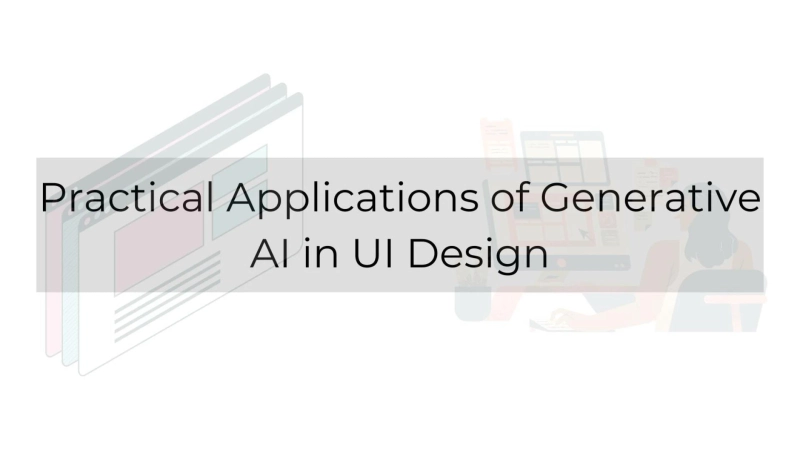Generative AI has revolutionized UI design by providing practical and futuristic solutions. It is no longer just a theoretical concept but a reality transforming how designers work. By leveraging the power of this technology, designers are enhancing user experiences and streamlining design processes.
In this blog, we will delve deeper into the world of Generative AI in UI design, exploring some of its most compelling applications. We will showcase how Generative AI makes a tangible impact, enabling designers to create more efficient, intuitive, and personalized user interfaces.
So, get ready to discover the exciting possibilities of Generative AI in UI design!
Possibilities of Generative AI in UI design
Automating Routine TasksGenerative AI excels at automating repetitive and time-consuming tasks that can bog down the creative process. One example is creating multiple design iterations for various screen sizes and resolutions. With the help of AI, designers can automate this process and save a significant amount of time, which they can then use to focus more on the strategic and creative aspects of UI design.
By automating these tedious adjustments, designers can also reduce the risk of human error and ensure that their designs are consistent across all platforms. In essence, generative AI empowers designers to work more efficiently and effectively, ultimately leading to better outcomes for clients and end-users.
Enhancing CreativityArtificial Intelligence (AI) has revolutionized the way we approach creativity in design. It's not just about automation; AI-powered tools offer many new ways to explore design possibilities. For instance, AI-driven design assistants have become increasingly popular among designers due to their ability to generate multiple design options quickly. These design assistants use vast databases of design rules and elements to propose innovative combinations that a designer might need to consider.
This approach can lead to unexpected and inspiring design solutions, pushing the boundaries of traditional UI conventions. AI-powered design assistants reduce the time and effort required to create multiple design options and provide a fresh perspective that designers might not have considered before.
This results in more creative and innovative designs that effectively communicate the desired message while keeping the user experience at the forefront. In conclusion, AI-powered design assistants have opened up new avenues for creative exploration in design. By leveraging the power of AI, designers can create designs that are more innovative, unique, and effective in meeting users' needs.
Real-Time PersonalizationGenerative AI has a wide range of applications in UI design, but one of the most fascinating ones is real-time personalization. The use of AI algorithms in analyzing user interactions in real-time and making adjustments to the UI to suit individual preferences better is a game-changer in the field of user experience.
By studying a user's behavior, the AI can identify which features of an app are frequently used by the user and modify the UI accordingly, making those features more accessible.
This level of personalization leads to an improved user experience and increased satisfaction. The AI-powered real-time personalization feature enhances the overall usability of the application and provides a more seamless and intuitive experience for the user.
Rapid PrototypingGenerative AI has emerged as a powerful tool that can significantly expedite the prototyping phase of design. With the help of AI-powered tools, designers can quickly generate a functional mockup based on their initial design inputs. This allows them and the stakeholders to see and interact with a prototype much earlier in the design process, ultimately accelerating the development cycle.
By leveraging the power of AI, designers can obtain quicker feedback on their designs, enabling them to make necessary adjustments and ensure that the final product is well-tuned to user needs.
In addition, generative AI can help designers identify potential issues or bottlenecks in the design at an early stage, allowing them to address these issues before the final product is launched.
Overall, generative AI in design can transform the product development process, resulting in faster prototyping, more efficient design iterations, and a final product better aligned with user needs.
Predictive DesignAI-driven predictive design tools have revolutionized the way designers create user interfaces. By leveraging machine learning algorithms, these tools analyze vast amounts of data to forecast trends and user preferences, providing designers with valuable insights into their designs' potential future.
This predictive capability is particularly useful for creating forward-compatible UI elements. By anticipating how user behaviors and preferences may change over time, designers can develop designs that remain relevant and effective in the long term.
Moreover, predictive analytics can suggest which design elements will engage users based on historical data and emerging trends.
This helps designers decide which design features to prioritize, ultimately leading to more intuitive, engaging, and user-friendly designs.
Overall, AI-powered predictive design tools have become essential resources for designers who want to create cutting-edge user interfaces that meet their users' ever-evolving needs.
The practical applications of Generative AI in UI design are vast and varied. From automating mundane tasks to enhancing creative processes and enabling real-time personalization, AI is not just changing how designs are created; it's transforming what is possible in user interface design.
As this technology continues to evolve, it will undoubtedly unveil even more innovative and efficient ways to approach UI design, making it an exciting time to be in the field.



